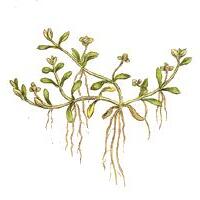Herbs or small shrubs, sometimes aquatic. Leaves opposite or verticillate, simple or submerged leaves sometimes much divided, entire or serrate; stipules present, paired. Flowers small, regular, hermaphrodite, axillary, solitary, cymose, fasciculate or in glomerules, occasionally cleistogamous. Sepals (2–)3–5(–6), free, imbricate, not nerved or 1-nerved, mostly with pellucid margins. Petals (2–)3–5(–6), hypogynous, imbricate, persistent. Stamens as many as and alternate to twice as many as the petals, free, hypogynous; anthers dithecous, opening by longitudinal slits. Ovary superior, (2–)3–5-locular, with axile placentation; ovules numerous; styles (2–)3–5, free. Fruit a septicidal capsule. Seeds straight or curved, without or with very little endosperm; embryo straight or curved, with short cotyledons
Herbs [subshrubs], annual [short-lived perennial], synoecious [polygamous]. Leaves opposite [whorled], simple; stipules present; petiole present or absent; blade margins entire or serrulate; venation pinnate. Inflorescences axillary, usually cymes or flowers solitary, sometimes 2[–3]-flowered clusters. Flowers bisexual [pistillate]; perianth and androecium hypogynous; hypanthium absent; sepals 2–5, distinct or connate basally; petals (0 or) 2–5, distinct; nectary absent; stamens [0–]1–10, distinct, free; anthers dehiscing by longitudinal slits; pistil 1, 2–5-carpellate, ovary superior, 2–5-locular, placentation axile; ovules 2–33[–44] per locule, anatropous; styles 2–5, distinct; stigmas 2–5, capitate. Fruits capsules, dehiscence septicidal or irregular. Seeds 2–33[–44] per locule.
Herbs annual, perennial, or subshrubs, semiaquatic or terrestrial, dwarf. Leaves opposite or verticillate, petiolate; stipules paired; leaf blade simple, margin entire or serrate. Flowers solitary, clustered, or in axillary cymes, bisexual, actinomorphic, small. Sepals 2-5, imbricate, free or slightly united, thinly membranous or with nearly pellucid margins. Petals 2-5, imbricate in bud, free, membranous. Stamens 1 or 2 × as many as sepals, free; anthers dorsifixed, 2-loculed. Ovary superior, 2-5-loculed, many ovuled; placentation axile; styles 2-5, free, short; stigmas capitate. Fruit a septicidal capsule, membranous, leathery, or crustaceous. Seeds numerous, straight or curved, small; testa often rugose; endosperm absent.
Stamens from as many to twice as many as the petals, free, hypogynous; anthers 2-celled, opening by longitudinal slits
Flowers small, actinomorphic, bisexual, axillary, solitary or in small cymes, fascicles or verticillate clusters
Stamens as many, or twice as many as the sepals; anthers 2-thecous, opening by longitudinal slits
Leaves opposite or verticillate, simple, entire or toothed; stipules present, paired
Ovary superior, 3–5-celled; placentation axile; styles 3–5, free; ovules numerous
Seeds without endosperm, straight or curved; embryo with short cotyledons
Flowers small, actinomorphic, hermaphrodite, axillary, solitary or cymose
Seeds without endosperm, straight or curved; embryo with short cotyledons
Leaves opposite or verticillate, simple; stipules present, paired
Ovary superior, 3–5-locular, multiovulate; styles 2–5, free
Petals as many, hypogynous, imbricate, persistent
Petals 3–5(6), imbricate, persistent
Sepals 3–5, free, imbricate
Fruit a septicidal capsule
Fruit a septicidal capsule
Sepals 3–5, imbricate
Herbs or low shrubs
Herbs or low shrubs

